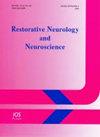Pituitary adenomas and COVID-19 related disease in pandemic time: Clinical, pathological, immunohistochemical, and ultrastructure analysis
IF 1.6
4区 医学
Q4 NEUROSCIENCES
引用次数: 0
Abstract
Introduction: Methods: 47 patients were emergency operated on due to pituitary apoplexy during the pandemic time. The patients were divided into two groups according to PCR COVID-19 positive vs negative test. Histopathology all cases showed varying degrees of necrosis, microthrombi formation secondary to inflammation, and endothelial cells injuries in association with TNFa, TNFk, FVIII, DPGF, HIF1a, Il6, Il10, Il17, DPGF, CD3, CD4, CD8, CD20, CD68, CD163, ACE2, and antiCOV immunoexpression. Results: 24 women and 23 men, age ranges from 21 to 76 years (mean 42.25±13.38), 14 (36%) presented positive COVID19 tests, and 30 (64%) were covid negative. 15 were already recurrences, 4 recurrences in the same year, and 4 died during the pandemic time. 9 (30%) showed histological data of stroke, of which necrosis around <25% were 8 (47%), 25-50% were 2 (12%) and >50% were 8 (45%). Weak vascular changes in 4 (24%), moderate in 7 (65%) and severe in 1, moderate, and intense in 1 (6%) were observed. Conclusions: Apoplexy in a previously diagnosed macro-PAD in the setting of a recent COVID-19 infection. The patients who presented with histological features of pituitary tumor infarction alone had less severe clinical features on presentation, a longer course before presentation, and a better outcome than those presenting with hemorrhagic infarction or frank hemorrhage. Hyperactivated and dysregulated immune cells pose a substantial danger for exacerbated tissue damage. COVID-19 may increase the risk of pituitary apoplexy, and we should be vigilant for signs of this. A more insidious pathological link between COVID-19 and apoplexy may exist in addition to severe inflammatory response.大流行时期垂体腺瘤与COVID-19相关疾病:临床、病理、免疫组织化学和超微结构分析
方法:对大流行期间47例垂体卒中患者进行急诊手术治疗。根据PCR阳性和阴性结果将患者分为两组。所有病例的组织病理学均显示不同程度的坏死,继发于炎症的微血栓形成,内皮细胞损伤与TNFa、TNFk、FVIII、DPGF、HIF1a、Il6、Il10、Il17、DPGF、CD3、CD4、CD8、CD20、CD68、CD163、ACE2和抗冠状病毒免疫表达有关。结果:女性24例,男性23例,年龄21 ~ 76岁,平均42.25±13.38岁,阳性14例(36%),阴性30例(64%)。15例已经复发,4例同年复发,4例在大流行期间死亡。9例(30%)有脑卒中组织学资料,其中坏死约50%,8例(45%)。轻度血管改变4例(24%),中度血管改变7例(65%),重度血管改变1例,中度血管改变1例,重度血管改变1例(6%)。结论:在最近感染COVID-19的情况下,先前诊断的宏观pad发生卒中。单纯表现为垂体肿瘤梗死的患者在发病时的临床特征较轻,发病前病程较长,预后较出血性梗死或直接出血的患者好。过度激活和失调的免疫细胞对加剧的组织损伤构成实质性的危险。COVID-19可能会增加脑垂体中风的风险,我们应该警惕这种迹象。除了严重的炎症反应外,COVID-19与中风之间可能存在更隐蔽的病理联系。
本文章由计算机程序翻译,如有差异,请以英文原文为准。
求助全文
约1分钟内获得全文
求助全文
来源期刊
CiteScore
5.40
自引率
3.60%
发文量
22
审稿时长
>12 weeks
期刊介绍:
This interdisciplinary journal publishes papers relating to the plasticity and response of the nervous system to accidental or experimental injuries and their interventions, transplantation, neurodegenerative disorders and experimental strategies to improve regeneration or functional recovery and rehabilitation. Experimental and clinical research papers adopting fresh conceptual approaches are encouraged. The overriding criteria for publication are novelty, significant experimental or clinical relevance and interest to a multidisciplinary audience. Experiments on un-anesthetized animals should conform with the standards for the use of laboratory animals as established by the Institute of Laboratory Animal Resources, US National Academy of Sciences. Experiments in which paralytic agents are used must be justified. Patient identity should be concealed. All manuscripts are sent out for blind peer review to editorial board members or outside reviewers. Restorative Neurology and Neuroscience is a member of Neuroscience Peer Review Consortium.

 求助内容:
求助内容: 应助结果提醒方式:
应助结果提醒方式:


